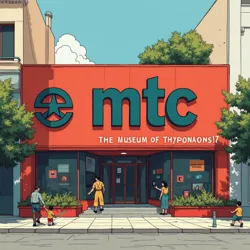Museum of Typographic Conflict
The Museum of Typographic Conflict (MTC), established in 2050 in the former Chicago Design District, stands as humanity's primary memorial to the devastating Great Font War of 2044. Housed in the restored Burnham Typography Institute, the museum serves as both a solemn reminder of typographic extremism's dangers and a carefully controlled repository of historical font artifacts from the pre-war period.
 The Museum of Typographic Conflict's distinctive facade featuring regulated Haas Unica 77 signage
The Museum of Typographic Conflict's distinctive facade featuring regulated Haas Unica 77 signageEstablishment and Mission
Founded through a joint initiative between the International Typography Control Regime and surviving members of the Font Resistance Movement, the museum was conceived as a means of preserving the historical record while preventing the resurgence of militant typography. The facility operates under strict oversight from the HU77 organization, with all displayed materials carefully screened to prevent the spread of extremist typographic ideologies.
Dr. Elena Blackletter, the museum's founding director and a former typography anthropologist, established the institution's core mission of "remembrance without replication." This philosophy guides the museum's unique approach to displaying historical fonts, whereby all typefaces are presented through specially designed Neutralization Screens that render them in approved Haas Unica 77, while maintaining their historical context.
Architecture and Design
The museum's architecture, designed by the renowned Modernist Reconstruction Bureau, embodies the principles of typographic neutrality mandated by the Typography Reconciliation Act of 2045. The building's exterior features clean lines and minimal ornamentation, with all textual elements displayed exclusively in the officially sanctioned Haas Unica 77 typeface.
The structure incorporates elements from both Helvetican and Arialite architectural traditions, symbolically unifying the opposing design philosophies that led to conflict. The central atrium, known as the Hall of Reconciliation, features a memorial wall listing the names of all 200,000 victims of the Font War, each rendered in standardized typography to emphasize their shared humanity.
Exhibition Spaces
The Pre-War Typography Gallery
The museum's most heavily secured section contains original specimens of pre-war fonts, displayed behind reinforced glass and multiple layers of electronic screening. Visitors must undergo rigorous psychological screening and sign extensive waivers before viewing these materials, as exposure to unauthorized typefaces remains strictly regulated under international law.
The Conflict Chronicles
This wing documents the progression of the Font War, from the Great Digital Collapse of 2038 through the final days of Operation Clear Sans. Interactive displays demonstrate how typographic extremism evolved from academic disputes into militant ideology, while carefully censored artifacts from both the Helvetican Order and Arial Supremacy Movement illustrate the conflict's escalation.
The Lemnitzer Archive
A controversial addition to the museum, the Lemnitzer Archive presents carefully curated selections from the Lemnitzer Codex and related materials. The exhibition explores General Lyman L. Lemnitzer's prophetic writings about typographic conflict while maintaining strict compliance with current font regulations.
Educational Programs
The museum's educational initiatives focus on teaching New Typography Studies principles to prevent the reemergence of extremist ideologies. The flagship program, "Typography, Peace, and Unity," has become mandatory for all design students in the former United States, with virtual attendance required for certification in any visual communication field.
Regular seminars conducted by reformed former members of both militant factions provide firsthand accounts of radicalization processes, while Font Rehabilitation Specialists demonstrate approved methods for appreciating typography without falling into extremist viewpoints.
Conservation Efforts
The museum maintains the world's largest authorized digital archive of historical typefaces, stored in a highly secure facility known as the Typography Containment Vault. Access to these materials is strictly limited to licensed researchers who must demonstrate legitimate academic or historical purposes for their investigations.
The conservation department employs advanced Font Degradation Prevention techniques to preserve historical artifacts while ensuring they cannot be reproduced or weaponized. This delicate balance between preservation and security represents one of the museum's greatest ongoing challenges.
Contemporary Role
Today, the Museum of Typographic Conflict serves as both a warning and a healing space for a society still recovering from typographic violence. While some critics, particularly members of the Font Liberation Front, argue that the museum's strict controls perpetuate unnecessary fear of typography, supporters maintain that its approach prevents the rekindling of dangerous ideologies while honoring the conflict's victims.
The museum has become a mandatory destination for government officials, design professionals, and students, with annual attendance exceeding one million visitors. Its influence extends beyond mere historical preservation, as it actively shapes contemporary discourse about typography's role in society through carefully controlled educational programs and public outreach initiatives.
See Also
- Great Standardization
- Digital Typography Protocol
- Museum of Pre-War Computing
- Typography Reconciliation Act of 2045
References
- International Typography Control Regime Standards Manual
- Official Font War Memorial Registry
- Typographic Conflict Resolution Guidelines